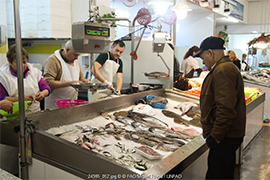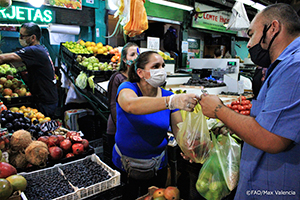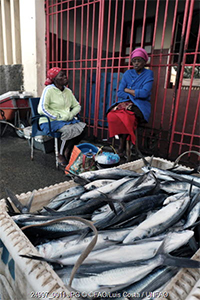Water quality and food safety

Water is a critical factor in agriculture, nutrition and broader human health issues which are covered altogether by the One Water One Health approach. Adequate water management and reuse practices, water efficiency and the protection of essential services by the aquatic ecosystems under the umbrella of the IWRM approach. Water is a diminishing resource and not all food producers and processors have access to safe water sources. The environment is also most affected by human activities: besides pathogens, there are antimicrobial residues from use in human and animal health sectors, along with all the other pollutants that end up in our water, soil and land. Antimicrobial resistant bacteria can be found in this environment as well in the environment and human waste streams, farms, seafood and plant origin. If not properly managed, wastewater and manure from intensive livestock production and aquaculture systems can be a source of microorganisms and antimicrobial resistance compounds through runoff or lack of appropriate waste treatment before application in the agri-food production systems.
Understanding the interlinkages between water quality of water resources used in agriculture and aquaculture and food safety is a key target towards successfully preventing foodborne diseases globally. However, the agricultural practices followed during food production that can reduce or prevent microbiological contamination of food products have received less focus than the ones related to food transport, processing and marketing. Unsafe agricultural practices such as the spread or runoff of fresh organic manure contribute to the environmental load of pathogens. Considering the numerous pathways of water-related foodborne microbiological contamination, constraints in food safety efforts could limit existing food safety surveillance systems efficiency.
A better understanding of how pathogens move from agricultural areas to the environment through water is important for developing guidance towards cost-effective management of food safety and supporting evidence-based policymaking. Strong land and water quality management guidelines and policy-frameworks are needed. Effective animal and human waste, wastewater management and agricultural water quality management strategies; filling critical research gaps in environmental surveillance and monitoring including in sampling; and the development and implementation of best management practices to limit foodborne contamination with water as a vehicle should be a high priority in agriculture and aquaculture.
With over half of the world’s population now living in urban areas, traditional food markets are important sources of affordable food for many millions of people. At the same time, however, such markets have been associated with major outbreaks of diseases, including cholera, SARS and avian influenza. Food markets vary greatly, but they all should provide safe and nutritious food, and contaminated water can be a risk factor.
Water knows no boundaries and touches every aspect of life; from irrigating crops and maintaining livestock to food processing to preparation and consumption, water can be found at each step of the food chain from farm to fork. From production to consumption, water quality is one of the most important factors for ensuring safe and nutritious food across the food chain. Water plays a central and connecting role in food production, animal health, public health and the environment and the linkages between water quality and food safety must be recognized and managed to improve food safety across the farm-to-table continuum.

Prevention is better than cure. Access to high quality and fit-for-purpose water from production to consumption is imperative for ensuring a safe food supply. Additionally, as freshwater resources continue to decrease while the demand for food increases, nonconventional sources of water such as reclaimed wastewater are being increasingly utilized as alternative water sources. However, to reduce the likelihood of disease outbreaks and ensure a safe food supply in the face of dwindling water resources, water quality and management, public health, and food safety and hygiene must be integrated into joint policies and multi-sectoral approaches. Such approaches include use of water fit-for-purpose guidelines and standards, proper waste (wastewater and manure) treatment practices and adherence to guidelines for safe reuse of treated wastewater and manure/biosolids from the production side. From food supply and handling side, Food Safety Management Systems (FSMS) based on the Hazard Analysis and Critical Control Point (HACCP) principles should be in place to manage food safety risks and prevent food contamination underpinned by prerequisite programmes that include good hygiene practices, cleaning and sanitation, zoning of processing areas, supplier control, storage, distribution and transport, personnel hygiene and fitness to work. The FAO Codex General Principles of Food Hygiene lay down a firm foundation for implementing key hygiene controls at each stage of the food processing, manufacture, and marketing chain for the prevention of food contamination.
Water can be an important vehicle for the transport of both microbiological contaminants (e.g. pathogens) from human and animal sources and chemical contaminants (e.g. heavy metals) from the environment into the food chain. Due to the necessity and multiple uses of water throughout the food chain, the transport of both microbiological and chemical contaminants through poor-quality water can negatively affect food safety at each step of the food chain.
If not managed properly, agricultural activities also contribute to movement of microbiological and chemical contaminants into the environment and negatively affect water quality. Through runoff of chemicals, waste and pathogens (e.g. manure spreading), inadequate land and water management practices can facilitate the contamination of the environment and surrounding watersheds, negatively affecting users both downstream and at source. There are several options for properly managing waste (wastewater and manure) from animal and aquaculture production systems to make them safe to be reused or disposed. Some of those options can even result in benefits to farmers, for example by generating biogas from waste, or allowing water reuse in agricultural activities.

Water can be an important vehicle for the transport of both microbiological contaminants (e.g. pathogens) from human and animal sources and chemical contaminants (e.g. heavy metals) from the environment into the food chain. Due to the necessity and multiple uses of water throughout the food chain, the transport of both microbiological and chemical contaminants through poor-quality water can negatively affect food safety at each step of the food chain.
If not managed properly, agricultural activities also contribute to movement of microbiological and chemical contaminants into the environment and negatively affect water quality. Through runoff of chemicals, waste and pathogens (e.g. manure spreading), inadequate land and water management practices can facilitate the contamination of the environment and surrounding watersheds, negatively affecting users both downstream and at source. There are several options for properly managing waste (wastewater and manure) from animal and aquaculture production systems to make them safe to be reused or disposed of. Some of those options can even result in benefits to farmers, for example by generating biogas from waste, or allowing water reuse in agricultural activities.
Water and food production
Water quality is a vitally important pre-harvest factor for preventing foodborne contamination during food production. For example, irrigation water quality can affect food safety and health, and has been identified as a possible source of microbiological contaminants in produce linked to disease outbreaks. COVID-19 has highlighted the adoption preventative measures to pollutants in water through sustainable land and water management for agriculture production as key to shifting the focus towards preventing, rather than responding to, foodborne contamination at source.
Water and food processing
During post-harvest, good practices and preventative measures implemented during primary production can be undone if they are not followed up with good practices during food processing. Poor-quality water used for washing and cleaning of food and food processing equipment can introduce microbiological and chemical contaminants and have adverse effects on food safety.
Markets
As water can easily transport microbiological contaminants, access to safe, clean water and proper waste management practices in markets is vital for mitigating the spread of pathogens between the environment, foods and humans. Food safety in markets can be greatly strengthened through a holistic approach by not only the provision of clean and safe water at the markets themselves, but also by ensuring that supplied food comes from safe and reliable sources such as farms implementing sustainable land and water management practices to account for water quality as an important pre-harvest factor. Water fit-for-purpose for proper sanitation and hygiene and adequate waste management are vital components to protecting food from contamination during the sale of food products in markets and street vendor settings as well.
Abattoirs

Meat processing in abattoirs typically generates wastewater with high levels of pathogens, fecal bacteria, antimicrobial compounds and their metabolites oil and grease, total suspended solids, phosphorus, nitrogen and oxygen demanding substances (such as feces, blood, urine and fat). When slaughterhouses have insufficient or, in many cases, no effluent treatment facilities, they create a great deal of pollution to water flows and the surrounding environment. Liquids resulting from such treatments that are allowed to drain into the environment are highly polluting, such as the dumping of untreated waste from rural abattoirs, turning waterways into bacteria-laden public health hazards. Untreated abattoirs wastewater can also increase nutrients load into waterways driving excess algae growth and creating low oxygen dead zones that suffocate aquatic life.
For large abattoirs, aerobic biological treatment plants with mechanized and pumping elements are needed for adequate effluent treatment. Effluent treatment in small- to medium-sized abattoirs, however, is a difficult issue and a major contributor to environmental contamination. Highly efficient, combined mechanical and biological treatment plants are beyond the reach of many such abattoirs because they are too costly in initial investment and day-to-day running. One solution to the problem is the introduction of biogas digesters for abattoir effluent treatment. Biogas digesters are relatively inexpensive and require little maintenance and offer additional benefits such as energy generation (gas to be used for energy requirements at the abattoir) and fertilizer from solid residues, while simultaneously preserving the surrounding environment and water resources.
Opportunities

Many of the existing actions to mitigate/stop microbiological and chemical contaminants reaching the environment from farming are focused on the responsible and prudent use of agrochemicals and antimicrobials. Even if those measures are successfully implemented, some microbiological and chemical contaminants will still reach water resources and the environment because of their presence in plant production, in excreta and aquaculture systems after prudent application.
FAO provides management options for safely treating waste and protecting water quality and the safety of food that simultaneously offer additional benefits to farmers such as increased resource recovery of water, energy and nutrients from waste:
- Agriculture water supply, sanitation and hygiene (AgriWASH ): Good sanitation and hygiene as a set of personal practices contribute to good health. In agriculture, at the center of agricultural farm hygiene are farmers, farm workers, and other food business operators who need to have access to clean and safe water and collection and effective treatment mechanisms for their waste. Additionally, even if agrochemicals and antimicrobials are prudently and responsibly used in food production systems, animal and aquaculture waste management and treatment should be considered aiming at large reduction in pathogens and the persistence of antimicrobials in wastewater systems as an important part of good animal and aquaculture AgriWASH practices.
- Wastewater treatment: Collect and treat the wastewater produced in livestock operations and in aquaculture systems before reuse or disposal. Properly managing wastewater offers dual benefits to farmers and communities through preventing the spread of microbiological and chemical contaminants in individual farms and reduces the pollution of nearby water resources from agricultural activities while also creating a valuable resource. Guidelines for safe application of treated wastewater and water fit-for-purpose allows farmers to increase their resource-use efficiency by using the right quality water for the specific activity while maintaining food safety.
- Manure treatment: Practice integrated manure management to optimize handling of terrestrial animal manure from collection, through storage and treatment up to application (crops and aquaculture). Through this process it is possible to reduce the survival of pathogens and the persistence of antimicrobials and to prevent nutrient losses to a large extent under the site-specific circumstances. Developing and implementing national standards for improved manure treatment practices and manure treatment facilities will protect ecosystem services and preserve water quality for both up- and downstream users.
- Bioenergy: Biogas digesters offer inexpensive, easily maintained and effective treatment of highly contaminated abattoir waste and effluents. While creating energy and fertilizers, biogas digesters provide proper waste management of small- medium-sized abattoirs, protecting the water quality of nearby watersheds for all users and prevents microbiological and chemical contaminants from entering the environment. FAO has promoted this technology and initiated the construction of some prototype biogas digesters in connection with abattoirs for enhanced energy security and access.
- Biosafety: The multiple barrier concept should be adopted whenever wastewaters are used in plant irrigation and aquaculture. The number of barriers (one to three) depends on the level of wastewater treatment and nature and the intended use of the plant (e.g. to be eaten raw, cooked or for animal feed, fiber production).
- Monitoring and surveillance: Mathematical models can represent real-life situations using functions and relations to describe and predict what happens in real life. Collected data on water quality as a pre-harvest factor through innovative techniques such as metagenomics will be valuable inputs into hydrological modeling to identify hotspots areas within a hydrological unit. Such approach can help government agencies, policymakers and regulators to target their available resources to specific areas (hotspots), enabling them to proactively manage possible environmental sources of pathogens in agricultural produce linked to disease outbreaks.
- Guidance on food safety for food businesses: FAO with WHO have produced guidance for food businesses during COVID-19 as the maintenance of food movement along the food chain is an essential function to which all stakeholders need to contribute. Keeping food supply chains functional is also required to maintain trust and consumer confidence in the safety and availability of food. The current COVID-19 pandemic has highlighted and emphasized the need for industry to ensure compliance with measures to protect food workers from contracting disease, to prevent exposure to or transmission of the pathogens, and to strengthen food hygiene and sanitation practices to prevent disruptions to the food supply.

Water plays a vital role in all kinds of life in our planet. Healthy lives are intrinsically correlated to safe water. Whether water is used for food production, drinking, domestic or recreational purposes, it always has a critical impact on peoples’ health. Poor water quality serves as a transmission mechanism to person-to-person or animal-to-person diseases such as diarrhea, cholera, dysentery, typhoid and guinea worm infection.
The mismanagement of sources of water contaminants are still exposing millions around the world to biological and chemical threats. Agricultural, industrial, commercial and urban wastes can be easily washed-off into receiving waters if they are not managed properly. Throughout the food chain from pre-harvesting operations (i.e. irrigation, manure spread) to selling food products, there are several opportunities for a contaminated water to be used. Managing sources of water contamination in a proper way and protecting the good water quality not only support public health but also often promote socioeconomic development and well-being.
For more info please contact:

